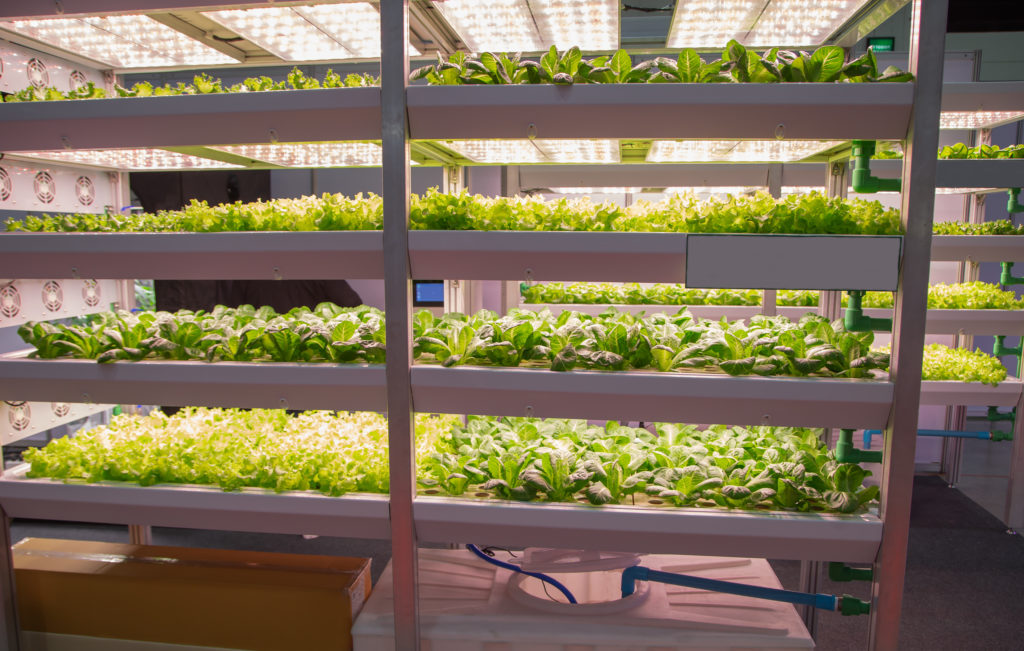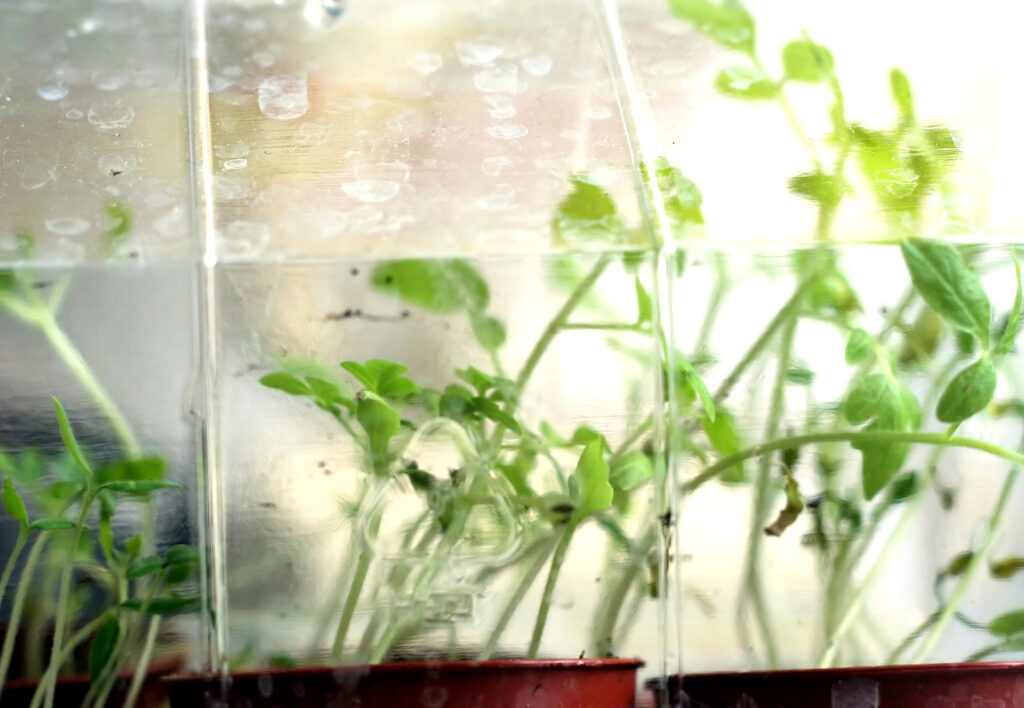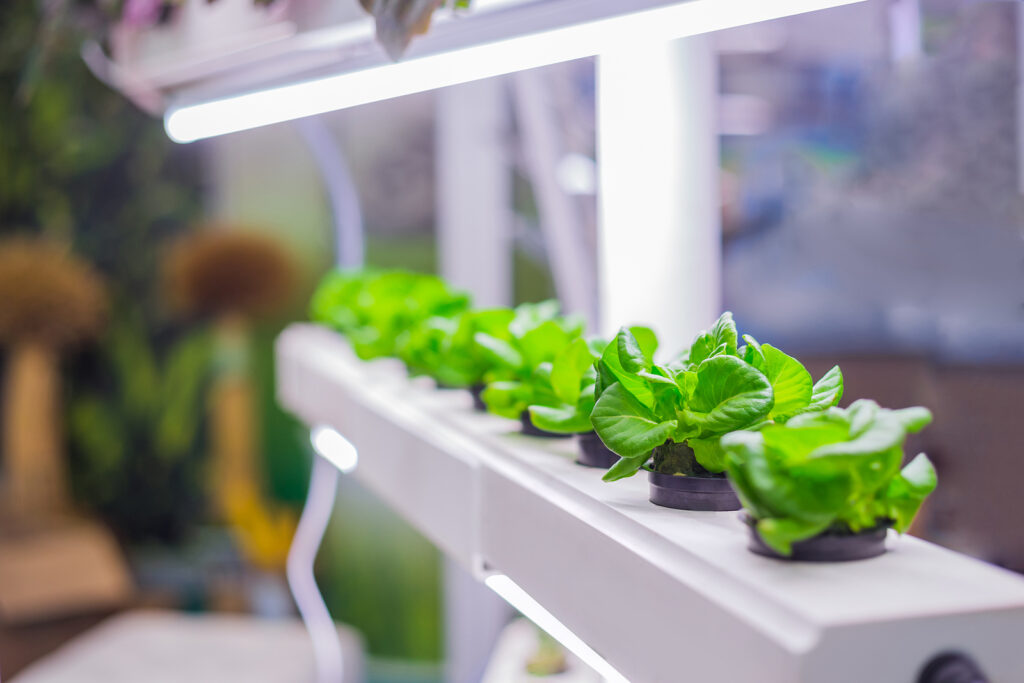A grow light is an artificial light source that mimics the natural sunlight required for plants to thrive. Grow lights are also known as plant lights or propagation lights.
Grow lights are important for indoor seed starting and plant growing. They allow for the growth of a wide range of plants regardless of the available natural light.
Grow lights allow the grower to extend the growing season and grow plants year round. Grow lights can deliver consistent light, regardless of the season or prevailing weather conditions. Grow lights allow plants to make thier own food, or photosynthesize, indoors and away from natural sunlight. Grow lights are ideal for seed starting and seedlings growth as they provide consistent light that can be controlled at this delicate state in a plant’s life.
There are different types of grow lights with differing features that cater to the specific needs of various plants. Three popular types of grow lights are fluorescent, LED (light-emitting diode), and HID (high-intensity discharge). Each has its own set of advantages, making it important to select the type that suits your plants’ requirements and growth stage.
See also: Lights to Grow Plants: Choose the Right Light

Grow light types
When choosing a grow light, it’s important to consider factors such as the size of your growing area, the type of plants you want to grow, and your budget. LED grow lights are known for their energy efficiency and long lifespan, making them a popular choice for both professional gardeners and hobbyists. HID lights, such as metal halide and high-pressure sodium lights, are commonly used for large-scale indoor gardens, as they provide intense light output. Fluorescent lights are affordable and emit a balanced spectrum of light, making them suitable for seedlings and young plants, however, fluorescent lights are being phased out of production as of September 2023.
LED lights
LED — Light-Emitting Diode (LED) — lights have gained wide popularity in recent years due to their efficiency and customizable light spectra. A light-emitting diode is a semiconductor device that emits light when current flows through it.
LEDs allow gardeners to tailor the light spectrum for different growth stages. LEDs produce less heat compared to other types of grow lights, reducing the risk of burning plants. LED lights tend to have a longer lifespan and lower energy consumption, making them a cost-effective choice in the long run.
Unlike other types of grow lights, LEDs do not require a separate ballast. They are also adjustable, allowing the grower to customize the light spectrum based on the specific needs of plants. LEDs emit a specific range of wavelengths that are ideal for photosynthesis, promoting healthy growth and maximizing yields.
There are different types of LED grow lights available, each with its own unique features and advantages. The first type is the white LED grow light, which produces a broad spectrum of light that closely resembles natural sunlight. This mimics an outdoor growing environment and is suitable for all stages of plant growth. Another type is the red and blue LED grow light, also known as a dual-banded LED grow light. These lights emit a combination of red and blue wavelengths, which are essential for the two main stages of plant growth – vegetative and flowering. The red spectrum promotes flowering and fruiting, while the blue spectrum enhances plant growth during the vegetative stage.
Full spectrum LED grow lights are the third type, and they provide the complete range of light wavelengths required for plant growth. These lights include not only red and blue but also other colors such as green, yellow, and orange. Full spectrum LED lights can be customized to match the specific needs of different plant species, making them highly versatile.
LED grow lights can be categorized based on their wattage and coverage area. Low-wattage LED lights are suitable for small-scale or hobbyist gardeners, while high-wattage lights are designed for commercial growers with larger cultivation spaces. The coverage area refers to the surface that the grow light can effectively illuminate, and it is an important factor to consider when selecting the right LED grow light for your garden.

High-intensity discharge lights
High-Intensity Discharge (HID) grow lights are a popular choice among indoor gardeners and horticulturists due to their efficiency and effectiveness in promoting plant growth. HID lights are known for their intense and powerful light output, making them suitable for various stages of plant development, including germination, vegetative growth, and flowering.
There are two main types of HID grow lights: Metal Halide (MH) and High-Pressure Sodium (HPS). Metal Halide (MH) lights emit a bluish-white light spectrum that closely resembles natural sunlight, making them ideal for the vegetative phase of plant growth. They provide the necessary light energy for healthy leaf development, photosynthesis, and strong stem growth. High-Pressure Sodium (HPS) lights emit a reddish-orange light spectrum, which is perfect for the flowering and fruiting stages of plants. HPS lights promote the production of fruits, flowers, and essential oils in plants, resulting in better overall yield and quality.
HID lights are highly efficient in converting electrical energy into usable light for plants. They have a high lumen output per watt, meaning they generate a significant amount of light without consuming excessive energy. This makes HID lights a cost-effective option for large-scale indoor gardening projects. Moreover, HID lights also have a long lifespan, which allows gardeners to use them for extended periods without worrying about frequent replacements.
One disadvantage of HID lights is their heat generation. Due to their high light output, HID bulbs produce a considerable amount of heat, which can be detrimental to plants if not managed properly. Adequate ventilation and cooling systems are necessary to maintain the appropriate temperature levels in a grow room or indoor garden. Additionally, HID lights require a ballast to regulate the amount of electrical current flowing to the bulb, ensuring stable light output and preventing damage to the unit.
Fluorescent lights
Fluorescent lights are one of the most commonly used types of grow lights. They are widely used by beginners and those with smaller indoor gardens. They are cost-effective and emit a wide spectrum of light that is suitable for most plants. Fluorescent lights are energy-efficient and do not generate as much heat as some other types of grow lights. However, linnear fluorescent lights contain mercury and as of September 2023 they are besing phased out of production.
Fluorescent lights come in two main forms: compact fluorescent lamps (CFLs)–which are designed to replace incandescent light bulbs and tube fluorescents. CFLs are compact, easy to install, and ideal for small indoor gardens. Tube fluorescents, on the other hand, provide more intense light and are better suited for larger spaces. Tube fluorescents require a tube fixture; CFL’s can be screwed into a standard light socket.
Compact fluorescent lights (CFLs) are a common choice for beginners and small-scale indoor gardens. These lights are energy efficient and emit a balanced spectrum of light that can be easily absorbed by plants. CFLs are available in different wattages and color temperatures, allowing growers to tailor the light to their plants’ specific needs. They are also compact, making them suitable for tight spaces and low ceiling heights.
Tube fluorescent lights come in two different variations – T5 and T8. T5 flourescent tubes have a thin tube design; they are shorter and about 40 percent smaller than T8 fluorescent tubes, but are capable of producing just as much and sometimes more light in a smaller area. T5 lights deliver light that is close to natural sunlight. T5s are ideal for use in small grow spaces or where heat management is a concern. T8 lights are longer and wider than T5 lights. T8 fluorescent tubes are commonly used for seedlings and small plants.
A third type of fluorescent light is the High Output (HO) fluorescent lights which are designed for larger indoor gardens or commercial operations. HO flurorescent lights emit a powerful light output that can effectively penetrate the canopy of dense vegetation. HO fluorescent lights are commonly used in applications such as growing vegetables, herbs, and flowers. They offer excellent energy efficiency, ensuring that plants receive sufficient light without consuming excessive electricity.
Other grow lights
Ceramic Metal Halide (CMH) Grow Lights: CMH lights combine the benefits of metal halide and high-pressure sodium lights in one fixture. They emit a full spectrum similar to natural sunlight, providing optimal conditions for photosynthesis. CMH lights are versatile, suitable for both vegetative and flowering stages, and are known for producing high-quality yields. They are also more energy-efficient than traditional HID lights, making them a greener option for growers.Lastly, induction lights are another option for indoor gardeners. These lights are known for their long lifespan and energy efficiency.
Induction lights produce a similar light spectrum to HID lights but offer a longer and more consistent performance. They are also low-maintenance and have a broader coverage area, making them a suitable choice for larger gardens.

Grow light use tips
Consider the specific needs of your plants. Different plants require different levels of light intensity and duration. Some plants thrive in full sun, while others prefer partial shade. It’s important to research the specific lighting requirements of the plants you intend to grow, and choose a grow light that can provide the necessary light spectrum and intensity.
Ideally, your grow light should be placed in an area that allows for even light distribution. This means avoiding any obstructions that could block or cast shadows on your plants. Consider the height of the space as well – taller plants may require a higher placement of the grow light to ensure adequate coverage.
Consider is the heat output of the grow light. Some grow lights can produce significant amounts of heat, which can affect the temperature in your growing space. It’s important to choose a well-ventilated area, or even invest in additional cooling options, to prevent overheating and damage to your plants.
Choosing the right location for your grow light plays a critical role in the success of your indoor garden. By understanding the specific needs of your plants, considering the layout of your space, and taking into account factors like heat output and flexibility in setup, you can create an ideal environment for your plants to thrive. With a well-placed grow light, you’ll be on your way to enjoying a healthy and bountiful indoor garden.
Many grow lights come with adjustable mounts or hanging kits, allowing you to customize the height and positioning of the light source. This flexibility can be particularly useful in maximizing light coverage and ensuring that every plant receives the optimal amount of light.

Grow light buying tips
Selecting the right grow light is crucial for the success of your indoor garden. It is important to consideer factors such as light intensity, spectrum, energy efficiency, heat dissipation, and durability to make an informed decision that meets your specific gardening needs.
Light intensity
Consider the intensity of light emitted by the grow light. Different plants have different light requirements at various stages of growth. For instance, leafy greens generally require lower light intensity compared to fruiting plants. Consider the wattage and coverage area of the grow light to ensure it meets your specific needs.
Light spectrum
The light spectrum emitted by a grow light plays a crucial role in plant growth and development. Different wavelengths of light are responsible for various physiological processes, such as photosynthesis and flowering. Look for a grow light that offers a balanced spectrum of red and blue light, as these are the most important for plant growth. Some advanced models even offer adjustable color ratios to cater to specific plant requirements.
Energy efficiency
Choosing an energy-efficient grow light not only helps save on electricity bills but also reduces the carbon footprint. Look for grow lights that have the Energy Star certification, as this indicates that they meet strict energy efficiency standards. LED grow lights, in particular, are known for their energy-saving capabilities and long lifespan, making them a popular choice among indoor gardeners.
Heat dissipation
Grow lights tend to emit heat, which can negatively impact plant health if not managed properly. To prevent overheating, choose a grow light that has effective heat dissipation mechanisms such as built-in cooling fans or heat sinks. This ensures that your plants receive adequate light without risking damage or stress from excessive heat.
Durability and warranty
Investing in a quality grow light is a long-term investment, so it is important to consider durability and warranty. Look for grow lights made from high-quality materials that are sturdy and resistant to wear and tear. Additionally, check the warranty offered by the manufacturer, as it reflects their confidence in the product’s performance and durability.
More Buyer’s Guides



